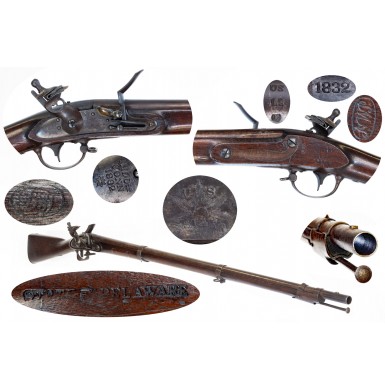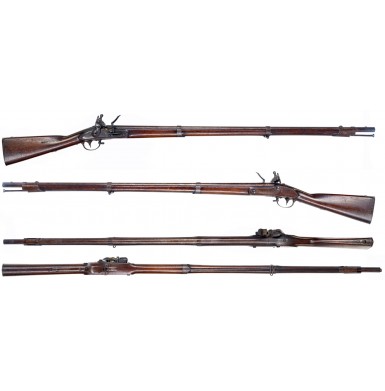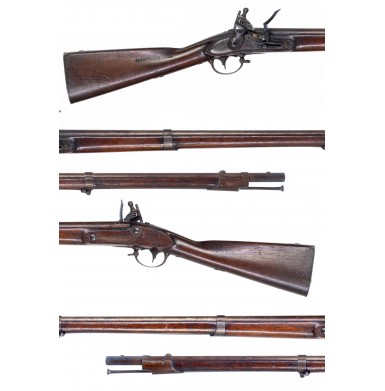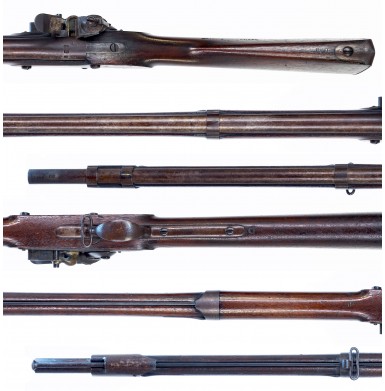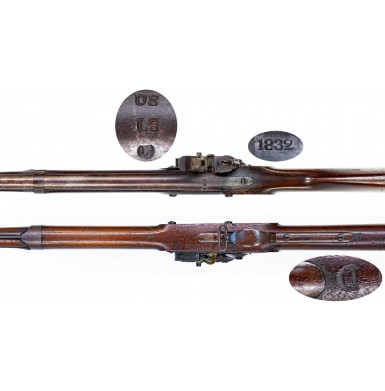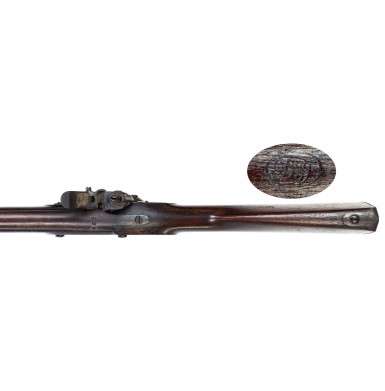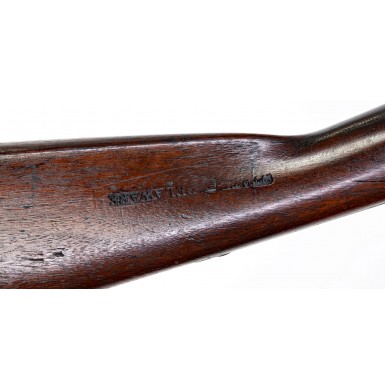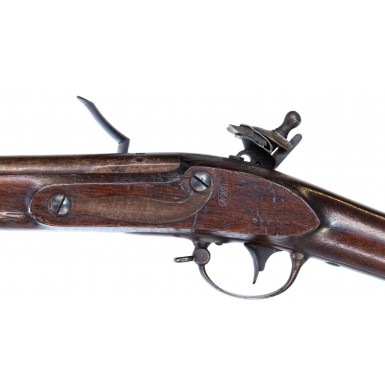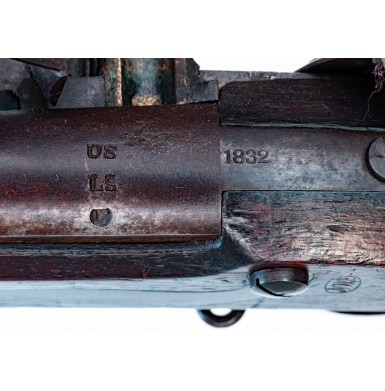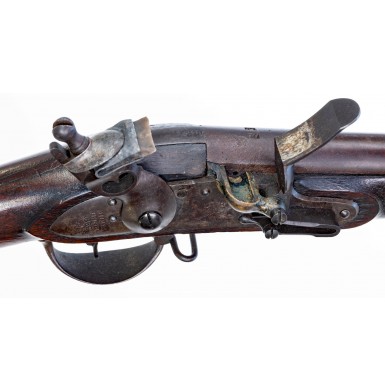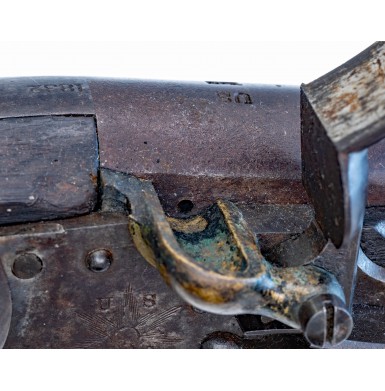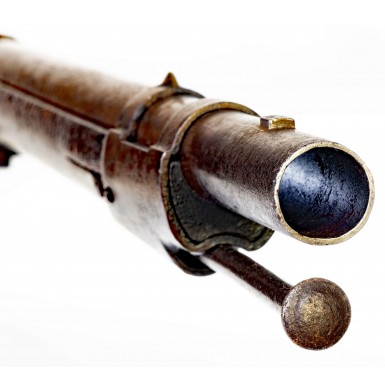Rare State of Delaware Marked US Model 1822/28 National Armory Brown Musket by Nathan Starr in Original Flint
- Product Code: FLA-4000
- Availability: Out Of Stock
-
$3,995.00
In 1812 the US military began the process of improving and upgrading the design of the “Charleville Pattern” muskets then in use by the army, which were being produced at Springfield, Harpers Ferry and by various contractors. The project would take some three years, would involve the production of a number of model and sample guns, and would incorporate ideas gleaned from Eli Whitney’s state contract arms from the first decade of the 1800s. Additionally innovations from all levels of the US government, from the director of procurements (predecessor to the chief of the ordnance department) to input from arms inspectors and workmen at the national armories were taken into consideration as the new model of arm was developed.
The resulting Standard Model of 1815 would be the first truly “American” designed military musket to be put into widespread production. As the name of the pattern implied, one of the primary motivations in the adoption of the new design was to standardize production. Up until this point, the arms of “Charleville Pattern” (US Model 1795 muskets) manufactured at Springfield and Harpers Ferry were different enough that for a very long time, collectors thought they were actually two different patterns of musket. No level of standardization existed in the arms delivered by contractors either, as in the era of non-interchangeable parts, the contract arms were produced by copying a pattern arm supplied by one of the armories, and thus the contractors working from a Harpers Ferry pattern musket produced a gun different from those working from a Springfield pattern. The goal of the Standard Model of 1815 was to rectify this, improve upon known deficiencies in the “Charleville Pattern” arms, and to take the first baby steps towards interchangeability of parts. The pattern went into production in 1815 and like most US arms of the era, immediately went through a number of small changes (noted as Type I-Type IV) by collectors, over the next three years, with the “Standard Model” being produced from 1815 through 1818. These are the muskets that have long been misidentified as the Model of 1812, based primarily upon the fact that the design process that resulted in these muskets had started in that year. The evolution of the Standard Model of 1815 soon resulted in the identification of areas of design that should be addressed and improved. Most notably the stock design, which had been radically altered from the “Charleville Pattern” by making it more robust and adopting a lower comb and a thicker wrist, was further altered by lowering the comb even more and extending the rail of the butt. A multi-year debate about band spring placement and type was finally resolved, and a new, rounded lock plate was adopted. Even though the new stock profile would begin to appear on muskets produced in 1816, the newly adopted Model 1816 would not really go into full production, with all newly made parts and not using older pattern parts on hand, until January of 1818. It was at that time that it was noted that the guns being produced at Springfield were “All of the new model.”
The US Model 1816 Musket would remain in production through about 1840 at the Springfield Arsenal and 1844 at Harpers Ferry and more than 800,000 of the muskets would be produced during that period between the two national armories and the various contractors who provided the arms as well. Over the years collectors have divided the “Model 1816” into three types, Type I, II and III. The musket offered here is a really lovely example of a US Model 1822/28 Musket Flintlock Musket produced with the National Armory Brown Finish, manufactured on contract by Nathan Starr and marked to the state of Delaware. For years, collectors would have referred to this model as the US Model 1816 Type II, but more recent scholarly research by author Peter Schmidt has revealed that the US Model 1822 was the new, replacement for the Model 1816 musket. Additionally, in 1828 it was decided to try to make the guns more uniform in terms of parts interchangeability and the dimensions of the primary components, thus the US Model 1816 Type III muskets are really US Model 1822/28 muskets. To muddy the waters further, under the old Type I, Type II, and Type III typography, it was noted that Type I and Type III muskets were finished “National Armory Bright”, while the Type II guns were “National Armory Brown”. Unfortunately, this oversimplifies the reality of the situation.
During process of adopting the physical changes that would be incorporated into the Model 1822, the discussion of a finish being applied to prevent rust was pursued, with the final decision taken was to adopt the English system of browning. By mid-1822, this was the standard finish for US muskets. National Armory Brown meant that the barrel and iron furniture received a deep, dark, lacquer brown finish to protect the metal from oxidation and corrosion. Additionally, the locks were left with their mottled, color casehardened finish, rather than being polished bright. The browning of muskets remained in general practice through at least late 1831 and was not fully abandoned until at least mid-1832. In fact, the letter to Nathan Starr, directing him to stop browning contract muskets is dated July 23, 1832, and reads in part:
“I am instructed by the Ordnance Department to inform you that after the browning materials now on hand at your armory are expended, that the browning of muskets will be discontinued, and the musket will be left bright for inspection.”
Depending on how much of the various chemicals Starr had in inventory, it is reasonable to believe that browning continued at his manufactory least through the summer of 1832 and possibly well into the fall of that year. Thus, the old designation based upon finish are simply incorrect, as Model 1822/28 muskets (aka “Type III” guns) were being produced for three to four years while brown finishes were still being applied. It is interesting to note that during the “National Armory Brown” period there are numerous letters and accounts of the finish itself causing corrosion and rust on the muskets, and it appears that this was one of the primary motivations to abandon the time consuming and costly process, as it apparently provided no more protection (and possibly less) than leaving the guns in their polished state. It is further worth noting that browning was never abandoned during the period of production of Hall rifles at the Harpers Ferry Rifle Works, and again letters exist commenting not only on the quality of the browned finish, but upon its protective characteristics and superiority to the browning done on muskets. Further study will note a difference in the color found on the Hall Rifles and the original arsenal brown on Model 1822 or Model 1822/28 musket, as the latter will have a very dark, almost black color to the brown, while the Hall will be a brighter brown with a slightly reddish tinge. The slightly different formula, and possibly the method of washing the barrels at Harpers Ferry appears to have contributed to the difference in the durability and color of the two finishes.
This particular Starr Model 1822/28 Musket is in FINE condition and remains in its original flintlock configuration and has not been altered to percussion or realtered to flint. The gun also bears the rarely encountered STATE OF DELAWARE ownership mark, stamped upside down on the obverse stock comb, near the wrist. According to Peter Schmidt’s research at the National Archives, Delaware received some 8,475 muskets from the US Government between 1816 and 1835, in roughly eleven different allotments. The majority of the arms were likely of the “1816” Pattern, whether Model 1816s, 1822s and 1828s. The guns were primarily delivered from the Pittsburgh Arsenal and from the Frankford Arsenal in Philadelphia. The gun retains some of its original National Armory Brown finish on the barrel and iron furniture, mixed with a lovely, somewhat mottled oxidized brown patina that makes the gun appear to retain even more finish than it does. The loss to the brown is primarily from age use and wear along points of contact and where the gun was regularly handled. The lock has a mottled and oxidized brown patina that has mixed with the dulled and faded original casehardened finish. While no real case colors remain, the mottled oxidation brings the mottled appearance of case coloring to mind. The lock of the musket is clearly marked in four vertical lines at the tail, behind the hammer:
MIDDTN
CONN
1832
*
with the “*” symbol really being an eight-pointed flower. The matching date 1832 is present on the breech plug tang. Forward of the hammer, the lock is marked with usual Nathan Starr motif of a {Rising Star}, with the letters US over it, and N. STARR in an arc under it. The inside of the lock retains the large majority of its original finish as well, including some bright fire blue on some of the various small parts. Most of the internal parts are marked with single letter inspection marks, with the letter E being encountered the most. The rear left quadrant of the breech of the barrel is clearly marked with a US/LS over a Raised-P in a depressed circle proof mark. The “LS” mark is that of armory sub-inspector Luther Sage, who spent fourteen days inspecting arms at Starr manufactory in February of 1832.
Starr, located in Middletown, CT, delivered US Model 1822 and Model 1822/28 muskets on multiple contracts for a decade, from 1829 through 1839. During this time Starr delivered slightly more than 19,000 muskets to the US government. Of those guns, only his initial contract for 5,000 arms (delivered between 1829 and 1831) would have definitively been National Armory Brown. It is likely, as noted above, that many of his 1832 deliveries from his second contract would be browned as well, like this example. With 2,260 muskets delivered in 1832, it is possible that Starr manufactured as many as 7,260 brown muskets, but the number is probably somewhat smaller than that.
The lock is mechanically excellent and functions perfectly in every way. A period flint is in the jaws and has a thin lead wrap as well, one of the materials often used to increase the ability of the jaws to hold the flint in place when the top jaw was tightened. The musket retains both of its original sling swivels and its original ramrod, which is full-length and fully threaded at the end. The .69 caliber bore of the musket is in FINEcondition and is partly bright with moderate amounts of scattered oxidation. The smooth bore shows some lightly scattered pitting but is in really wonderful condition for a musket that is nearly 190 years old.
The stock is also in FINE condition. The stock is really wonderful, with sharp, crisp edges and perfect wood to metal fit. There is no indication of the stock having been sanded. There are two inspection cartouches on the stock. The first is the script NWP of armory sub-inspector Nahum W Patch on the flat, opposite the lock. This was applied by Patch to the completed musket. The second cartouche is the final acceptance cartouche for contract arms, applied to the comb of the stock, in front of the buttplate tang by an Ordnance Officer. At Springfield, this mark was applied behind the triggerguard during this period, but for contract arms it was applied on top of the comb. The script DT mark is that of Lt. Daniel Tyler of the Ordnance Department. In 1831, Daniel Tyler was assigned to the “duty of superintending the proof & inspection of small arms manufactured on contract”. This had previously been the responsibility of the Chief of Ordnance, but the job of supervising the inspection of small arms had grown too large for a single Ordnance officer to handle. Inspectors Asabel Hubbard (AH), Justin Murphy (JM), Luther Sage (LS) and Nahum W Patch (NWP) all worked under Tyler to perform contract arms inspections during this period. Tyler’s cartouche remains in very good condition but is not quite as crisp as Patch’s cartouche on the counterpane. It is interesting to note that no reinspection cartouche rating the quality of the gun is present. The stock is very attractive and retains much of its original “feathery” texture on the butt. There are two tight grain cracks present on the counterpane, both emanating from the lock mounting screws. One is quite short, and one is about 1 ¼” in length. As would be expected for any military musket that is approaching its 200th birthday, the stock does show a handful of minor handling marks, bumps, and dings, but nothing significant or really worth mentioning. A capital letter D is neatly carved into the toe line of the stock, behind the triggerguard tang, the meaning of which is not clear.
It is worth noting that finding an original flint US Model 1822/28 musket produced in the 1830s in original flint is uncommon, as nearly all of them were subsequently altered to percussion by the Ordnance Department. In fact, any flintlock musket produced after 1831 were immediately designated as 1st Class (as long as they were not damaged) and were left unmarked as to a rating cartouche and were supposed to be altered to percussion. However, those guns in storage at state facilities that were not “National Arsenals” were not inspected and categorized. Some of those guns also managed to escape the alteration process, as the state would have had to request the alteration to percussion, as well as pay for it or take the alteration cost against their allotment of arms from the Militia Act of 1808 for that fiscal year. We know that this was a Delaware owned gun, as it is so marked, and that is how it managed to escape alteration to percussion.
Overall, this is a really nice example of a US Model 1822/28 (1816 Type II/III) flintlock musket in original flint. The state of Delaware ownership mark is an uncommon one to see on a US musket from the period and is really quite rare. If you have been wanting to add a crisp, National Armory Brown US Model 1822/28 musket to your collection in original flint, this would be a hard one to beat, particularly for the price. It would cost substantially more to significantly upgrade from this fine musket.
ON HOLD / LAYAWAY
Tags: Rare, State, of, Delaware, Marked, US, Model, 1822/28, National, Armory, Brown, Musket, by, Nathan, Starr, in, Original, Flint

